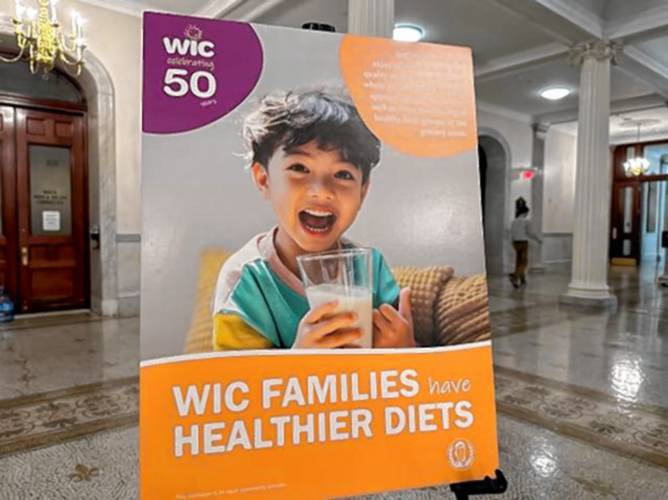WIC supporters mark 50 years of helping families grow

A poster celebrates the 50th anniversary of the Bay State's WIC program offering nutrition assistance to women, infants, and young children. STATE HOUSE NEWS SERVICE
| Published: 08-29-2024 9:44 AM |
The Department of Public Health this week celebrated the 50th anniversary of a program for mothers and children that boosts childhood nutrition and, in the words of one state representative, serves as a “buffer against hardship.”
Known as WIC, the Supplemental Program for Women, Infants, and Children is funded mostly by federal government but administered by the states. It offers assistance with buying healthy food, nutrition counseling, and breastfeeding support.
Around 126,000 participants in Massachusetts benefit from WIC every month across 31 local agencies, the program said, including 43.2 percent of all infants. Eligible recipients are pregnant, breastfeeding, and postpartum mothers, and babies, toddlers, and preschoolers under five years old. They must be state residents with a total household income less than 185 percent of the federal poverty level.
Bree McAlister, WIC’s senior nutritionist for the Franklin-Hampshire-North Quabbin region, said her family benefited from WIC when she was a child.
“I have learned that when families come to WIC, they aren’t just coming for free food. They’re coming for all the other services that WIC has to offer, like nutrition counseling, lactation support, referrals to programs like Early Intervention or Head Start. And sometimes they come in just needing an ear for someone to listen to them,” McAlister said at a State House event Tuesday featuring a large WIC birthday cake.
Momentum behind the program’s formation started in the 1960s, said Jess Saracino, acting deputy regional administrator for the U.S. Department of Agriculture. The national conversation on malnutrition was fueled by a CBS Reports documentary, “Hunger in America,” and the 1969 White House Conference on Food, Nutrition and Health hosted by President Richard Nixon.
The roots of many USDA programs trace back to the 1969 conference, she said. Congress authorized a two-year pilot program in 1972, and in 1974 Massachusetts was one of 45 states to start a permanent WIC program. The first Massachusetts site was in Cambridge, Saracino said, calling WIC “the nation’s most powerful evidence-based public health program.”
Dr. Robert Goldstein, commissioner of the state Department of Public Health, said that it became “the gateway for public health services” as Massachusetts hauled through the coronavirus pandemic.
Article continues after...
Yesterday's Most Read Articles
In 1983, Massachusetts became the first state to chip in supplemental state funding, which was bumped up to $15.4 million in the fiscal 2025 budget, an increase of around 15 percent over fiscal 2024.
State funding (line item 4513-1002) made it possible to serve 1,709 additional people per month in fiscal 2023, WIC said.
The program, which is organized under DPH, sent out $100 million last year in cash assistance that was spent at around 850 participating grocery stores, farmers’ markets, and pharmacies.
A booklet for program participants, called the Approved Food Guide, details healthy foods that the funds can be spent on: foods such as vegetables, whole grains, dairy, legumes, and fruit juices. Boxes of “not allowed” or “DO NOT BUY” foods include fruit packed in syrup, vegetables in sauce, and products with added sugars, fats, or oils.
Rep. James Arena-DeRosa, a Holliston Democrat who served as the regional administrator for USDA Food and Nutrition in the Obama administration, said WIC’s strength lies in directing its participants to proper nutrition which can feed into better long-term health outcomes as infants grow toward adulthood.
“Because of U.S. national subsidy policy, if I took a bottle of water, a bottle of soda, a bottle of milk, and a bottle of juice, the cheapest of those four is the bottle of soda, which is the least nutritious,” Arena-DeRosa said. “But it’s also the cheapest, which just doesn’t make sense, it’s never made sense to me. And sadly, healthy food in the United States is more expensive. It’s just not good for our long-term public policy. WIC, by design, insisted that the funding that we provide goes to nutritious food. Can’t buy soda with WIC.”
Besides serving as a “buffer against hardship,” the program also supports breastfeeding, something Arena-DeRosa and others described as critical. Breastfeeding can lead to better health outcomes and autoimmune systems, he said.
Goldstein said WIC was crucial to families during the 2022 infant formula recall and shortage, providing “continuous access to safe and appropriate nutrition.”
“Their work paid off. Breastfeeding rates improved, with the average breastfeeding initiation rate reaching an all-time high of nearly 85 percent. And the percentage of infants breastfeeding through at least six months increasing to over 40 percent,” he said of WIC’s efforts.
It’s a program with a “truly life-saving” impact, Saracino said, a point reiterated by Assistant Secretary Daniel Shark from the Executive Office of Health and Human Services.
“I was struck by the statistic that WIC-involved families see 35 percent reduction in infant mortality, versus families who do not receive WIC benefits,” Shark said. “And it just absolutely struck me, the impact of this program.”






 ‘It’s a Wonderful Night in Turners Falls’ showcases village businesses, nonprofits
‘It’s a Wonderful Night in Turners Falls’ showcases village businesses, nonprofits Sackrey Construction Co. of Sunderland celebrating 35 years in business
Sackrey Construction Co. of Sunderland celebrating 35 years in business Photo: As darkness falls
Photo: As darkness falls Leverett residents rap Kittredge compound plans, urge caution as negotiations for 400 homes move forward
Leverett residents rap Kittredge compound plans, urge caution as negotiations for 400 homes move forward 
